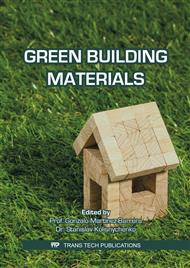[1]
R. Gellert, Inorganic mineral materials for insulation in buildings, in: M. R. Hall. Materials for energy efficiency and thermal comfort in buildings. Woodhead Publishing Limited, Cambridge, 2010. Chapter 8.
DOI: 10.1533/9781845699277.2.193
Google Scholar
[2]
T. Luamkanchanaphan, S. Chotikaprakhan, and S. Jarusombati, A Study of Physical, Mechanical and Thermal Properties for Thermal Insulation from Narrow-leaved Cattail Fibers. APCBEE Procedia, 1 (2012) 46 – 52.
DOI: 10.1016/j.apcbee.2012.03.009
Google Scholar
[3]
IBAMA Brazilian Institute of the Environment and Renewable Natural Resources. 2007). Information on http: /www. ibama. gov. br/qualidadeambiental/madeira/produtos_reg_ibama. pdf.
Google Scholar
[4]
I. R. F. Martins, Concreto de Alto Desempenho com Adição de Resíduos de Borracha de Pneu. [dissertation]. Ilha Solteira (SP): São Paulo State University Júlio de Mesquita Filho, (2005).
DOI: 10.21475/ajcs.2016.10.11.pne183
Google Scholar
[5]
C. F. Fioriti, J. L. Akasaki, Fabricação de blocos de concreto com resíduos de borracha de pneus. (2004).
DOI: 10.14295/holos.v4i2.349
Google Scholar
[6]
J. Fiorelli, D. D. Curtolo, N. G. Barrero, H. Savastano Jr., E. M. J. A. Pallone and R. Johnson, Particulate composite based on coconut fiber and castor oil polyurethane adhesive: An eco-efficient product. Ind. Crop. Prod. 40 (2012) 69– 75.
DOI: 10.1016/j.indcrop.2012.02.033
Google Scholar
[7]
ABIPA Brazilian Association of the Wood Panels Industry. 2014. Information on http: /www. abipa. org. br/numeros_I. php.
Google Scholar
[8]
W. C. Lewis, Thermal conductivity of wood-base fiber and particle panel materials. Research Paper FPL 77. (1967).
Google Scholar
[9]
F. M. Dias, Aplicação de resina poliuretana à base de mamona na fabricação de painéis de madeira aglomerada, in: F. A. Rocco Lahr, Produtos derivados da madeira: síntese dos trabalhos desenvolvidos no Laboratório de Madeiras e de Estruturas de Madeira, SET-EESC-USP. Escola de Engenharia de São Carlos - Universidade de São Paulo, São Carlos, 2008, pp.73-92.
DOI: 10.21041/conpat2019/v2pat21
Google Scholar
[10]
C. I. Campos, Produção e caracterização físico-mecânica de MDF a partir de fibras de madeira de reflorestamento e adesivos alternativos em diferentes teores. [Ph.D. thesis]. São Carlos (SP): University of São Paulo, (2005).
Google Scholar
[11]
M. S. Bertolini, M. F. Nascimento, F. A. Rocco Lahr and J. A. M. Agnelli, Accelerated artificial aging of particleboards from residues of CCB treated Pinus sp. and castor oil resin. Mater Res (São Carlos. Impresso). 16, n. 2 (2013) 293-303.
DOI: 10.1590/s1516-14392013005000003
Google Scholar
[12]
L. D. Varanda, M. F. Nascimento, A. L. Christoforo, D.A.L. Silva and F.A. Rocco Lahr, Oat hulls as addition to high density panels production. Mater. Res. 16, n. 6 (2013) 1355-1361.
DOI: 10.1590/s1516-14392013005000131
Google Scholar
[13]
ABNT. Brazilian Technical Standards Association. NBR 14810-3: Chapas de Madeira Aglomerada. Part 3: Métodos de Ensaio. Rio de Janeiro. (2006).
Google Scholar
[14]
W. N. Santos, Propriedades térmicas dos materiais poliméricos. Projeto de Pesquisa, Processo: 11/02943-4. Biblioteca Virtual FAPESP. (2011).
Google Scholar
[15]
American National Standards Institute ANSI A208. 1: Particleboard. Gaithersburg. (1999).
Google Scholar
[16]
X. M. Song, J. Y. Hwang, Mechanical properties of composites made with wood fiber and recycled tire rubber. Forest Prod. J. 51, n. 5 (2001) 45-51.
Google Scholar
[17]
F. A. Rocco Lahr, R. Fernandes and M. S. Bertolini, Influência da preservação CCB na dureza da madeira de Pinus sp. In: Congresso Brasileiro de Ciência e Engenharia de Materiais, 19, 2010, Campos do Jordão. Anais.. Campos do Jordão: [s. n. ]. CD-ROM. (2010).
DOI: 10.55592/cfb.2022.8782827
Google Scholar
[18]
N. Ayrilmis, U. Buyuksari and E. Avci, Utilization of waste tire rubber in manufacture of oriented strand board. Waste Manage. 29 (2009) 2553–2557.
DOI: 10.1016/j.wasman.2009.05.017
Google Scholar
[19]
M. Ghofrani, A. Rabiei, Study of the physical and mechanical properties of composite boards made of a mixture of poplar chips and recycled tires. Environ. Sci. 6, n. 1 (2008) 123-129.
Google Scholar
[20]
D.G. Macedo: Composites made with wood chips and tire rubber residues [Ph.D. thesis]. Brasília (DF): University of Brasília, (2008).
Google Scholar
[21]
J. Khedari, N. Nankongnab, J. Hirunlabh and S Teekasap, New low-cost insulation particleboards from mixture of durian peel and coconut coir. Build. Environ. 39 (2004) 59 – 65.
DOI: 10.1016/j.buildenv.2003.08.001
Google Scholar
[22]
P. Lertsutthiwong, S. Khunthon, K. Siralertmukul, K. Noomun and S. Chandrkrachang, New insulating particleboards prepared from mixture of solid wastes from tissue paper manufacturing and corn peel. Bioresource Technol. 99 (2008) 4841–4845.
DOI: 10.1016/j.biortech.2007.09.051
Google Scholar
[23]
H. Benkreira, A. Khan and K. V. Horoshenkov, Sustainable acoustic and thermal insulation materials from elastomeric waste residues. Chem. Eng. Sci. 66 (2011) 4157–4171.
DOI: 10.1016/j.ces.2011.05.047
Google Scholar
[24]
X. Zhou, F. Zheng, H. Li, C. Lu, An environment-friendly thermal insulation material from cotton stalk fibers. Energ. Buildings. 42 (2010) 1070–1074.
DOI: 10.1016/j.enbuild.2010.01.020
Google Scholar
[25]
ABNT. Brazilian Technical Standards Association. NBR 15220: Desempenho Térmico de Edificações. Rio de Janeiro. (2003).
Google Scholar



